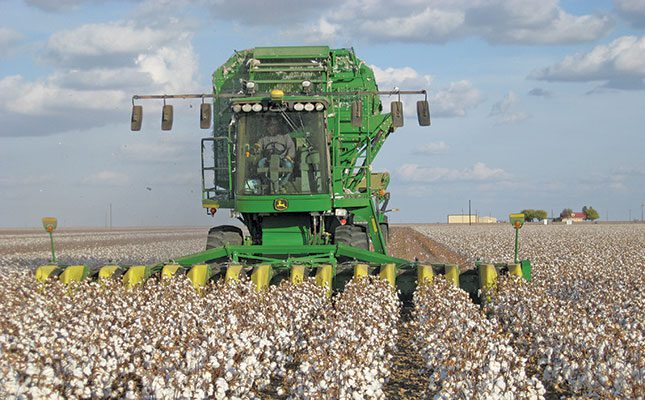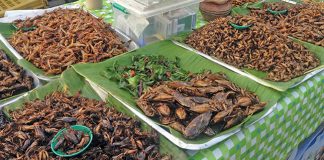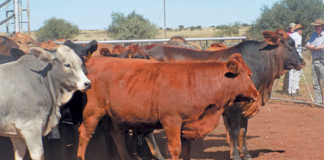
Photo: Flickr
Cotton is a major crop worldwide, and prior to the invention of the cotton harvester, it was a labour-intensive crop. And while mechanisation meant farmers’ need for manual labour decreased, their harvesting problems didn’t go away.
Cotton is harvested at the end of the growing season, and the plants mature at different times. To ensure maximum quality, the crop is harvested when around 60% of the bolls have defoliated and opened, say researchers Hussein Gharakhani et al (2022). This means the fibre in the bolls that open before the rest are exposed to the elements, and the longer they are, the lower the quality of the cotton becomes.
Moreover, say the researchers, high-capacity harvesters are heavy, and this can lead to soil compaction, making planting more labour-intensive and reducing the soil’s potential.
They also write that the high cost of harvesters requires a minimum of 600ha to 800ha of cotton available to harvest to justify the investment in a single machine. Thus, they argue that smaller, robotic machines may be the answer to farmers’ harvesting challenges.
Benefits
Gharakhani et al say that although robotic cotton harvesters aren’t as fast as large mechanical harvesters, they could be advantageous in terms of lower equipment and maintenance costs.
They also have potential for selective picking, allowing for flexible harvesting windows, as the robots can go to the fields throughout the season to pick the fibre as the boll opens. This will increase fibre quality and yield, leading to greater profits for farmers.
And, as producers often use chemical defoliation to make picking easier, robotic pickers could lower the need for such chemicals, as they mimic manual picking. The size of the robotic harvesters will also have less of an impact on soil compaction, ultimately leading to the sustained health and quality of the soil.
How they work
Robotic harvesters are already in use for the picking of other fruits and vegetables. “A harvesting robot generally consists of a vision-based perception system performing object detection and localisation, and a manipulator that positions an end-effector, which conducts the picking task.
“The end-effector, which is attached to the end of a manipulator (robotic arm), is used for detaching [the cotton] from [the] plants and dropping it into a receiving device,” say Gharakhani et al.
“Various end-effector designs employ different mechanisms for grasping and other interactions, including soft fingers, vacuum suction, oscillating saws, high electrical current, twisting fingers, rotating fingers, scissors, pruners, [and] thermal knives.
“Since each fruit type has specific physical and biological properties, most end-effectors for harvesting are custom-made. However, some features must be kept in mind by all designers, such as adaptability, which can provide the flexibility of accommodating different fruit sizes and orientations.”
To date, no robotic cotton harvester has been commercialised. In a study by Fue et al (2020), a robotic cotton harvester with a prebuilt rover as the platform used suction-type end-effectors with rotating gears at the tips to grasp the seed cotton.
“These obtained a picking success rate of 89% at a cycle of 17 seconds/boll in a simulated cotton field. The performance deteriorated to a success rate of 79% at 38 seconds/boll in an actual cotton field with defoliated plants,” explain Gharakhani et al.
Other prototypes have also been created, but overall, vacuum power has generally been used as a component on these prototype end-effectors.
“Seed cotton is different from other fruits in terms of its physical properties. Other fruits commonly have one contiguous rigid component, so when the end-effector grips part of the fruit, it can control the entire fruit. On the other hand, mature cotton bolls have four to five ‘locks’ of seed cotton, each of which contains multiple seeds with thousands of cotton fibres attached. If an end-effector attempts to pick the seed cotton of one lock, the seed cotton of the other locks and even a part of the seed cotton on the targeted lock may be left unpicked.
“Therefore, in our study, the performance of a robotic cotton harvester is defined in terms of picking ratio on a weight basis, for an individual boll. A picking ratio of 30% was considered the minimum threshold for a design idea to be acceptable,” write Gharakhani et al.
Transferring and doffing
There are numerous challenges when it comes to designing a robotic cotton harvester, and this begins with the picking process.
As mentioned above, the seed cotton in a boll is not a rigid fruit, which means that from the picking point to the collection point (when the fibre is removed from the end-effector and collected in a bin during a process called doffing), the seed cotton deforms.
If not picked properly, some of the fibre may be left in the boll, or may fall onto the ground during this process. If working on undefoliated plants, leaves and branches present the robotic harvester with further challenges, as the end-effector must be able to manoeuvre around these obstacles. This is why the end-effector must have precise targeting capability.
End-effectors must also be able to detect boll orientation to enable the robotic harvester to pick cotton in every position.
‘Stretched out’ picking
Gharakhani et al say that gripping a part of seed cotton in a boll may cause it to stretch out, allowing only a small portion to be picked, and leaving the rest unpicked while the gripped portion is stretched and pulled out of the boll. “[…] a carefully designed end-effector must pick, transfer and doff continuously to pick a boll clean of seed cotton”.
In order to make the robotic harvester accessible to small-scale farmers, it is important that costs be kept as low as possible.
End-effector concepts
In their study, the researchers experimented with multiple end-effector concepts to see which was more effective in robotic cotton harvesting.
Each prototype was evaluated in a preliminary experiment on 100 cotton bolls, and a picking ratio of 33% was assumed an acceptable minimum for a prototype to be considered potentially viable.
The two-finger gripper mimics the actions of the human hand, and is commonly used in end-effectors for robotic harvesting.
“The first option [we] considered was grasping, such as between a finger and an opposable thumb. To evaluate the concept, four layers of polyether ether ketone polymer were stacked at a total thickness of 1,7mm.
“The inner layer was covered with sandpaper to provide a jointed two-finger device with a high-friction surface,” explain Gharakhani et al.
They add that while the device could grasp the seed cotton, it tended to pick inefficiently, and only removed a portion of the seed cotton in the boll.
The eight-finger gripper was then considered. “Eight fingers were selected for expediency of assembly, and keeping the number of fingers low enough so as not to cause difficulty in penetrating plant foliage.
“A prototype eight-finger gripper was constructed, and it was expected to have a higher likelihood of grasping all the seed cotton in the boll. When picking, the gripper would expand and surround the cotton boll, then contract, and then it could be pulled backwards to remove the seed cotton.”
The researchers explain that while this gripper had a tendency to remove more of the seed cotton than the two-finger gripper, “it also tended to bend the associated branch and damage the boll (occasionally even plucking the entire boll), rather than simply removing the seed cotton from it. Even when only seed cotton was removed, the eight-finger design still didn’t remove all seed cotton from the boll”.
This gripper also seemed to have difficulty in doffing. “The main problem with this design was its tendency to bend the plant and pluck the entire boll, apparently because gripping power on the end-effector wasn’t controlled once the fingers were in the gripping position.
“Instead, after gripping, control was provided by a robotic arm as it pulled the entire end-effector back to pick the cotton. Based on this weakness, it was postulated that controlling fingers individually might improve the precision of the end-effector.”
Rotating spindles and paddles
The study also considered multiple rotating spindles in a step towards powered fingers. “The spindle concept is currently employed in cotton-harvesting machinery around the world. An end-effector based on this concept could work continuously and would be less likely to damage the cotton boll or stem.
“Hence, efforts were focused on prototyping and evaluation of the rotating-spindle end-effector concept. Rotating spindles didn’t bend the stem or damage the boll, but they also didn’t always remove all seed cotton from the boll, and doffing continued to be a challenge.
“This concept also had the occasional problem of removing a stem that would get stuck in the spindles. A variant on the rotating-spindles concept was that of rotating pinned paddles, which presented the possibility of more efficient removal of seed cotton because of the deeper engagement by the pins, and possibly also easier doffing,” they say.
A rotating device consisting of paddles with pins protruding from them was also designed and prototyped.
“Testing of the prototype showed that it didn’t ingest stems and get stuck like the spindle design occasionally did.
“However, the picking ratio decreased substantially with this design. The pins, rotating in one direction, would sometimes push a cotton boll aside, making a part of it inaccessible to the end-effector and thus decreasing the picking ratio.”
Another problem, say Gharakhani et al, was boll orientation, as the end-effector could pick only with its side and not its tip. Doffing was also an issue.
“Test results with this prototype reinforced the idea of the need for an end-effector with precisely controlled fingers. A further step in that direction was to place linearly moving pins on a finger, which would likely not push a cotton boll aside, enabling picking bolls at various orientations, and also [possibly] enabling easy transfer of picked seed cotton.”
The concept of linearly moving pins rotating around a finger led to the design and construction of multiple prototypes. The pins were attached to a belt driven with a 12V DC gear motor. “[This] end-effector was designed to transfer the picked seed cotton backwards and doff it. A plastic chute holds the seed cotton against the pins to help them transfer the seed cotton towards the doffing zone.
“During preliminary testing, this device performed picking, transferring and doffing procedures continuously. Compared with rotating pinned paddles, the picking ratio increased because the end-effector could pick bolls with both its side and tip. However, the picked seed cotton occasionally got stuck in the middle of the transfer zone.
“This design had two major issues that should be addressed: low picking ratio, and transferring problems. Experimentation with a two-finger gripper suggested that increasing the number of fingers could lead to a higher picking ratio. If the extra fingers were properly arranged, the transferring issue could also be solved.”
More fingers, greater accuracy
“Increasing the number of fingers increases the picking surface area of the end-effector. Also, each finger can grasp the seed cotton along one side and at the tip. Taken together, these features should lead to a higher picking ratio. After picking a cotton boll, an end-effector must transfer the seed cotton toward the doffing point. In designing a picking device with multiple fingers, the fingers must work synergistically to pull the cotton to a common point. Otherwise, the fingers could pull the seed cotton in different directions, a situation that could force the belts in the fingers to stop turning ,” say Gharakhani et al.
“In a three-finger configuration, the seed cotton can be held by the fingers in a roughly cylindrical configuration so that it can be transferred without becoming stuck in the fingers. The fingers can be arranged around a circle with 120° of separation to provide the best transfer area and equal picking opportunity for all three fingers.
“For complete doffing by the end-effector, all fingers should doff the seed cotton at the same point. Otherwise, the seed cotton could become stuck in the fingers,” say the researchers.
However, increasing the number of fingers increases the overall surface area of the tip, potentially causing problems in penetrating plant foliage. Therefore, the tip of the end-effector should be designed to be as narrow as possible to enable better penetration.
Source: www.sciencedirect.com











